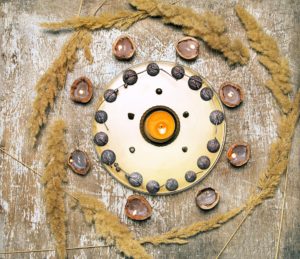
The concept of elemental powers predates modern Pagan practices. However, these old concepts have made their way into both reconstructionist and contemporary spiritual paths based on pre-Christian religions. In many sects of Wicca, five elemental powers are recognized in ceremonial rituals and other magic. Learning a little about how Wiccans have incorporated this concept in their spiritual practices can aid in an overall understanding of how humans in cultures all over the world apply these ideas.
A Brief History of Elemental Powers in Human Religions
While there is far from enough space in this article to describe every elemental force theory that has ever existed, it is useful to review the most common beliefs from ancient human cultures. Traditional Chinese philosophy includes the concept of five elemental forces, which was applied to everything from the arts to scientific thought to spirituality to military strategy. The Internet Encyclopedia of Philosophy describes “Wu Xing,” a collection of five mutable material forces that shape the universe: wood, fire, earth, metal and water.
The Wu Xing shares similarities with the five elements view in Hinduism, known collectively as the “pancha mahabhuta.” These include earth, water, fire, wind and a fifth item known as “akasha,” sometimes described as space or void. This, in contrast to the view of these aspects in the classical Greek world, which at first recognized only water, air, earth, and fire and regarded them as the unchangeable building blocks of nature. Nevertheless, Aristotle later added a fifth one, aether, which was said to exist above the terrestrial world and possibly based upon the akasha element in the Hindu Vedas.
Elemental Powers and Magic in Modern Wicca
An elementary forces theory has appeared in many contemporary Pagan practices, including modern Wicca. Many versions of the craft include a belief in the existence of five critical elements, likely derived from classical Hindu or Greek teachings on these forces. Earth, fire, water, air and aether are invoked during many rites such as ceremonial magic, weddings, baby blessings and even funerals.
Depending on the school of magic observed by the practitioner, substances or objects can be used to represent them. Fire, air, earth and water are aligned in many schools of Wicca with the “Four Quarters” and “calling the quarters” is a common ritual in many ceremonies:
- Earth, which corresponds with North and is represented by salt
- Air, which is in the East quarter and is invoked with incense
- Fire, aligned with the South and represented with a lit candle
- Water, associated with the West quarter
Many Wiccan traditions hold differing views as to the proper location and order of the elements on these cardinal compass points. Gardnerian Wicca has the static alignments as described above, while other thinkers suggest that the geography of the practitioner should determine which cardinal direction is associated with each one. For instance, Frederic Lamond proposed in his text “Fifty Years of Wicca” that North American Wiccans might allow water to correspond with the eastern quarter because of the placement of the Atlantic Ocean. Following such logic, practitioners in California might still associate water with the west because of the presence of the Pacific Ocean.
Contemporary Reapplication of Ancient Philosophies
Although modern human civilizations have come a long way from their ancient predecessors, some older ideas have been preserved, sometimes transformed for inclusion in today’s spiritual practices. The concept of elemental forces is fascinating and offers a small window through which a bit of ancient thought can be seen. While Wiccans may have adopted these concepts in slightly different formats for their practices, the idea of elements and their connection to magical forces remains as a broadly shared idea in several sects.

